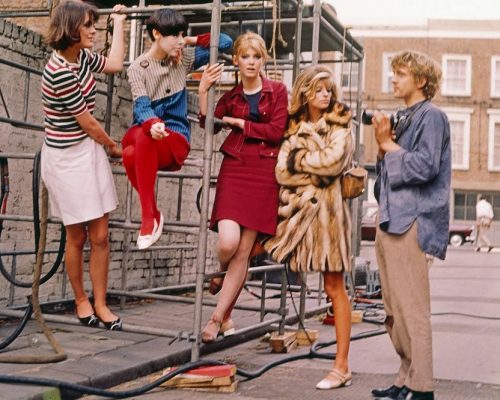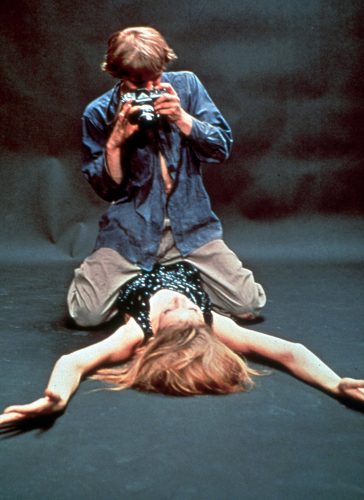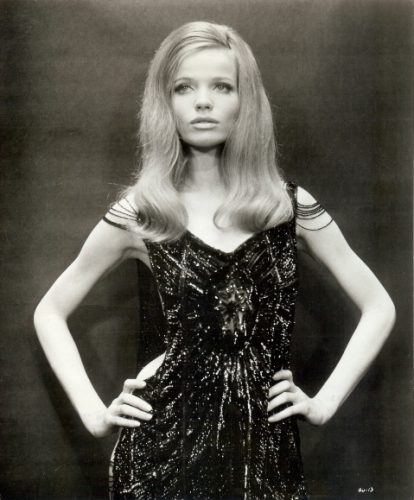Turner Classic Movies is presenting FOLLOW THE THREAD, a series of films broadcast on TCM cable on Saturdays in June and July. Each will be moderated by TCM with guests from the fashion industry, costume designers, academics or historians. The series is inspired by the Metropolitan Museum of Art’s Exhibition, In America: An Anthology of Fashion. Among the many movies, Bonnie and Clyde along with Blow-up will be shown on July 9.
Hollywood’s New Wave was born in the late 1960s with movies like Bonnie and Clyde and Blow-up. Bonnie and Clyde was the first to show the instant consequence of a man being shot, with its later footage (SPOILER), influenced by Akira Kurasawa’s Seven Samurai and the Kennedy assassination’s Zapruder film of the slow-motion, multiple machine-gunning of Bonnie and Clyde. Blow-up was the first general distribution movie to show full-frontal nudity. Blow-up not having passed the still present MPAA Production Code’s censors, MGM released it under the newly formed Premiere Productions. This heralded the collapse of the Production Code in favor of the current movie rating system.
Both movies were very influential on, and influenced by, street fashion. Theadora Van Runkle designed the costumes for Bonnie and Clyde. Van Runkle was self-taught as a costume designer. She had been an illustrator for the I. Magnin stores in Los Angeles, and had been a sketch artist for costume designer Dorothy Jeakins. She illustrated beautiful costume sketches that impressed producer Warren Beatty and director Arthur Penn, and she was tall and attractive and could wear the same clothes she designed for Faye Dunaway. But this was her first full movie assignment, and it turned into a bumpy road for her.
The job for any costume designer is to help develop character and advance the plot. Van Runkle started by reading the script and looking at old photos of Bonnie and Clyde, gangsters, and period clothes. She talked to Arthur Penn and Warren Beatty, and they wanted to put Fay Dunaway in dresses like Bonnie appeared in the photos. Van Runkle designed dresses and skirts for Dunaway, but they were cut on the bias and swung. The look of smart skirts, paired with a form fitting sweaters, Faye’s braless dressing, and a saucy beret cut an unforgettable image. Dunaway’s ivory-colored, fagotted seam sweater under her black wool suit was also striking.

But it was Faye’s berets that launched a fashion trend. Theadora liked the look, taking off from a photo of Bonnie Parker wearing a beret-looking hat, so she designed several of Faye’s outfits topped with a beret. The demand for berets became huge after the movie became popular. The men, Beatty and Gene Hackman, wore vested suits to do their bank robbing, with fedora hats. Off-work, they wore caps, which were more working class than fedoras.

Studio head Jack Warner hated the movie and would only provide limited distribution. But he sold Warner Bros. to Seven Arts at that time. Beatty finally convinced the new owners by reducing his profit participation share, to reopen the movie with wider distribution, and the movie became a hit.
Theadora Van Runkle was nominated for Best Costume Design for Bonnie and Clyde.
Blow-up has the trappings of a murder mystery but it is everything but. It is a film about the illusion of reality and the reality of illusion. It’s a film that circles on itself, spiraling towards a bull’s eye of life’s contradictions. It flashes scenes of beauty and gritty reality in equal proportions. Its central story is about a journey of discovery continually interrupted, an odyssey with the protagonist’s pursuits constantly distracted or detoured. There are no answers in Antonioni’s Blow-up, it’s like the pursuit of life itself – the blown-up life of modern society.
Blowup is a story that could only have been told on film. Perhaps it’s one of those “the medium is the message” phenomena, or it’s just that the story could only be told through the various arts combined in film. It was Michelangelo Antonioni’s creation, who wrote the screenplay, inspired by a short story from Julio Cortazar, and directed it in the swinging London of 1966. It portrays the flashy but empty life of a celebrity fashion photographer who views life through a lens and then follows the lens down a rabbit hole. Thomas, the photographer, is loosely based on photographers David Bailey and John Cowan, and who also has elements of Avedon in respect to that photographer’s later fascination with shooting gritty reality photos completely opposed to his beautiful fashion photography.
The film opens with a scene depicting one of its several displays of contradiction, wherein the noisiest element in a modern urban setting is a jeep-load of mimes, carousing through London. A quick cut then shows photographer Thomas, played by star David Hemmings, exiting a doss-house (the flophouses for the working homeless that still existed then) along with a line of down-and-out men. He’s dressed in torn clothes and unshaven. He wants to make a book about the photos he has taken there. He walks down a street and gets into his convertible Rolls-Royce. As he drives off he is later stopped by the mimes, then drives away. Contradictory visual images confront us on the street: two black nuns in white habits, and a Royal Guardsman guarding nothing.

He then drives to his studio where the impatient model Verushka (Verushka von Lehndorff playing herself) waits for him. They have a frenetic photo shoot which is a small masterpiece of cinema. The final shoot, where he straddles her, is like sex with a camera, the lens a phallic symbol of his power. He climaxes by getting all the shots he needs, quickly getting up and flopping on the couch, Verushka is left on the floor, unfulfilled and wanting more. It is apparent that in this sexually liberated film, sex for Thomas has been sublimated. In the next scene he shoots five models in ultra mod clothes, barking orders at them but clearly unengaged. One of the models is played by the iconic model Peggy Moffitt. As he is about to leave the studio two young aspiring models barge in wanting their photos taken.


Thomas seems to have it all. He has piercing blue eyes and the profile of Michelangelo’s David. Women and beautiful models flock to him. He drives a Rolls Royce and comes and goes as he pleases. He is handsome and cool. He listens to Herbie Hancock, whose soundtrack infuses the film. Yet he seems alienated from life, a searcher seeking he knows not what.
Thomas visits the flat next door, where his artist friend Billy is painting a canvas, living with his wife played by Sarah Miles. She and Thomas share an intimate past, but the nature of their relationship is not divulged. In one of the purest statements made about art in film, the artist says to Thomas, as they look at his painting, “They don’t mean anything when I do them. Afterwards, I find something to hang onto. Like that leg,” he points to his canvas, painted in a half-pointillist-half cubist style, the leg barely discernible. “Then it sorts itself out. It’s like finding a clue in a detective novel.” And thus said, the key to the whole movie is pointed out: art is a stand-in for life, yet life intrudes on the creation of art.
The film is filled with the Mod clothes of mid-60s London. The models in the early scene wore exaggerated versions of Mod outfits, a common slant for runway or editorial purposes. It is especially interesting to compare the Mod clothes of the young people shown with that of the older Londoners that walk the streets. The line between Mod and not was very pointed. David Hemmings’ garments were simple, and since the entire film took place over 24 hours, he only had two costume changes. Still his clothes were distinctive and showed him to be of the creative world vs. business: white denim pants, a wide black belt and black low-rise boots, a checked blue long sleeve shirt, which he wears without a t-shirt, and a dark forest green blazer. The model Verushka wears the most striking outfits: the opener in a sequined loose flowing but short dress open at the sides; and at the party a snakeskin and lozenge-patterned pants-suit with high suede boots. Although no screen credit is given in the film, Jocelyn Rickards is acknowledged as the dress designer. She was born in Melbourne Australia and moved to London in 1949 where she designed costumes for stage and screen.

Thomas continues his journey of art photography but then uses his camera as part of his day’s and night’s adventures meeting the character played by Vanessa Redgrave and running into The Yardbirds with Jimmy Page. His belief in the reality of photographs, and how continuously enlarging them will reveal truth, leads instead to disorientation.
Many viewers are disoriented and confused after viewing Blow-up. For an analyses of the movie, that the maestro Antonioni would not provide, see my blog post on the film HERE
Views: 929


I didn’t know Theadora Van Runkle’s early background. And, wish you could locate an image of her to illustrate her non-traditional look as a female costumer. Basically, she wasn’t Edith Head’s doppelganger.
With regard to Blow-Up, boy Christian, you catch every visual detail (and rightly so!). And, I especially appreciate your observation of the contrast of colors, e.g. the nun’s b/w contrast OR contrast of objects, e.g. “Thomas” engaged in doss house scene and soon thereafter gets into his convertible Rolls Royce. I think movie implies that cinema is a “living organism” and most appreciate insightful comment on movie by former USC film professor/movie critic, Arthur Knight, “as important and seminal a film as Citizen Kane, Open City and Hiroshima, Mon Amour – perhaps even more so.” Great and engaging blog! Keep them coming Christian!
Thank you Darlene for your perceptive comment and compliment. I have a couple of photos of Theadora Van Runkle, so I can select one to add to this post. And thank you for sharing
Arthur Knight’s comment about Blow-Up.
Great post! I love the fashions in Bonnie and Clyde, and Blow-Up sounds interesting. I see that it’s coming on TCM this month — thanks to your post, I’ll be tuning in.
Thanks for your comment Karen. It’s interesting that TCM will show both of these films back to back. The 1960s fashions are notable in both of them.